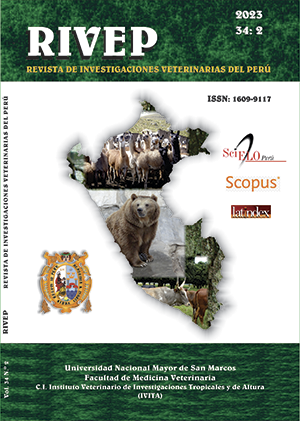Macroscopic description of the fetal ossification pattern in alpacas (Vicugna pacos)
DOI:
https://doi.org/10.15381/rivep.v34i2.25101Keywords:
ossification, gestation, alpacas, diaphanizationAbstract
Knowledge of embryonic and foetal development is extremely important in order to establish normal development parameters, the health of the foetus, and to identify critical periods in the growth curve. One of these processes is the pattern of ossification. The present study describes the ossification pattern in alpaca embryos and foetuses using radiology and diaphanization techniques. Seventeen pregnant female alpacas were used for the collection of embryos and foetuses of various ages (32, 45, 60, 90, 118, 150, 165, 190, 220 and 280 days). The specimens were weighed, measured and radiographed, and later fixed in 10% buffered formalin to be subjected to the diaphanization process in potassium hydroxide and finally stained with Alizarin Red. The description of the specimens indicates that in embryos of 32 and 45 days there are no mineralized structures; however, it can be seen radiopaque structures and signs of mineralization at 60 days, indicating that ossification would be starting between 45 and 60 days of gestation. The bones of the skull and the rib cage are the first to ossify. Ossification occurs consecutively in the vertebral column, thoracic and pelvic limbs, reaching an advanced state of ossification in the last third of gestation.
Downloads
Downloads
Published
Issue
Section
License
Copyright (c) 2023 Joel Iván Pacheco, Víctor Manuel Velez, Wilber Garcia, María Vasquez-Cachay, Celso Zapata, Daniel Lombardo

This work is licensed under a Creative Commons Attribution 4.0 International License.
AUTHORS RETAIN THEIR RIGHTS:
a. Authors retain their trade mark rights and patent, and also on any process or procedure described in the article.
b. Authors retain their right to share, copy, distribute, perform and publicly communicate their article (eg, to place their article in an institutional repository or publish it in a book), with an acknowledgment of its initial publication in the Revista de Investigaciones Veterinarias del Perú (RIVEP).
c. Authors retain theirs right to make a subsequent publication of their work, to use the article or any part thereof (eg a compilation of his papers, lecture notes, thesis, or a book), always indicating the source of publication (the originator of the work, journal, volume, number and date).










